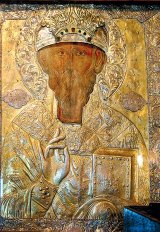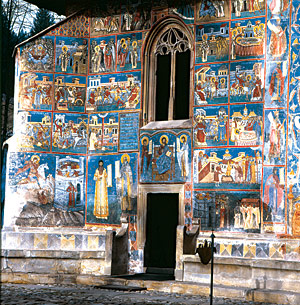Romanian Miraculous Orthodox Icons

"The Orthodox icon is not a depiction of divinity incarnate, but an arcane representation that serves to get in touch with divinity through contemplation and prayer. The icon brings to light, in a concentrated form, for contemplation, to infinite mystery of divinity. It is not the man-made copy of God (who is entirely non-corporeal, hence impossible to render in images), but God's presence as revealed in the embodiment of His Son, Jesus Christ." Paula Popoiu at www.orthodox-arizona.org
Romanian are deep believers. Not even 50 years of communism manage to shake their faith. They have a long history of Christianity that goes as far as 4th century AD. According with a census I found for 2002, over 86% percent of Romanian population is christian orthodox.
There are over 14.000 orthodox churches, cathedrals and monasteries, each of them having at least a dozen of icons, painted on walls, on iconostats (a special interior wall that separates the place for parishioners from the place where the priest officiate the cult) or framed as independent pieces. It is the last ones that are called miracle-working icons.
The icon worship is one of the major differences between Catholicism and Orthodoxy. An Orthodox church cannot function without an icon which, together with the Holy Bible and Holy Sacraments, is part of the rite. The icons are not an aesthetic object, but considered the link between believers and God. They are used for prayers in churches or at home, or other places like hospitals or penitentiaries.
All icons that have been sanctified by a priest are considered miraculous. Though, only 102 are recorded by the Romanian Orthodox Church as truly miracle-working icons. These icons are famous among believers and there are lots of testimonials that speak about their Divine potency. Most of them are St. Mary's icons but some represent other saints like St. Ana, St. Anton or St. Spiridon (a bishop who lived in Byzantine Empire around 300 AD).
As far as their stories are known today, these icons have not been made by humans hands but by divine Holy Spirit. It is said that one of them just appeared over night on a piece of wood where a painter had already started a Madonna, another had been found inside a tree, others have been painted by St. Luca, under God's guidance. Most of them have a long and complicated history that, according with general belief, backup their divine powers.
Their powers range from physical and spiritual healing to revelations. They cure diseases, they help young women getting pregnant, they make deaf people hear and mute people speak, they fulfill long lasting wishes, they help people find a mate or avoid divorce, the prevent thievery, they foresee the future, they ease one's soul, and even help with one's career.
The marvelous icons are hosted by churches and monasteries and everybody knows about them, one just has to ask. There is even a guide that was published few years ago, and now is being revised for a new edition.
In Bucharest there are two churches that have miracle icons within 5 miles of my former residence. But one has to meet certain criteria to be helped by St. Mary or any other saints. One condition is to bee a true believer or to want to believe. Just because you go to church and listen to the liturgy doesn't help. Then there's the sins. First you have to ask for forgiveness and be blessed by the priest. These are basics, but more sophisticated ones call for fasting and purity, for canons and prayers made regularly, for obedience and humiliation.


St. Spiridon is usually known as a healing saint. There are many holy places that have his icon but only one of them stand up: the icon that's hosted by St. Spiridon Old Church in Bucharest.
Four times a week, parishioners attend a special liturgy dedicated to St. Spiridon. It's starting with a common prayer, then the priest reads canons. There is a choir that sings from time to time. The light is dim and there's moments of silence. Most of the time you are knelt as a sign of your humble condition. This ritual last for one hour. Then you light a candle and make your way to the icons: Jesus, Madonna, St. Spiridon and other. You kiss their hands and make a cross sign for each of them. The last visited is the priest who blesses you, sometimes on Sundays giving you a the holly communion as bread soaked in red wine (it really tests very good). Some people kiss the priest's hand too, or just touch it with their forehead.
40 days you have to fast and pray this way for St. Spiridon to show his mercy. There have been recorded testimonials about his healing and the church is always crowded. Last year a hospital for poor children had been added with the help of famous Romanian gymnast, Nadia Comaneci.
Similar rituals and practices take place at other churches. Though some icons are less demanding and there are people speaking about their amazing miracles that happened only after a day of prayers.
I do not know how many people truly believe in miracles made by these icons. I, for sure, know lots of people who, at least once, went to a particular church just to pray to a certain icon. I also know people who's lives improved after one or more holly "sessions". They also say that, in the process, they gain strength, peace and hope. That's what it takes to go on with your life.
Here is a list of miracle-working icons and their location.

I'm not a great believer. Though, sometimes I think I am otherwise why I would pray to God when I need miraculous help, or understanding, or easiness, or smooth path towards an whatever goal I have for the moment.
Specially when snows because I'm afraid to drive on snowy or frozen roads. Then I must believe in God. But for sure I believe in miracles as I saw them happening and heard about them from others.
I grow up in my grandma house, my parents being busy working and coming home late afternoon. I more remember grandma home then ours, where we lived till I was 9 years old. On the eastern wall of her bedroom was an icon, St. Mary holding baby Jesus. It was a print icon, stuck in an wooden frame, with a candle aside and a bouquet of dried basil, immersed in a glass with holly water.
Every morning and every night, before bed, and any other occasion when time was hard, my grandma would kneel before St. Mary and say a prayer. Then she would touch the icon and sometime kiss the place where Mary's hand was. The Virgin heard her prayers and would watch for her. The icon had been sanctified by the priest through this act it became the vehicle to reach God.
Most of the icons are painted on wood, some on glass, and others right on the walls.The most important icons in a church are exposed in a dominant place. They are also heavy plated in gold or silver, according with the churches' wealth.









